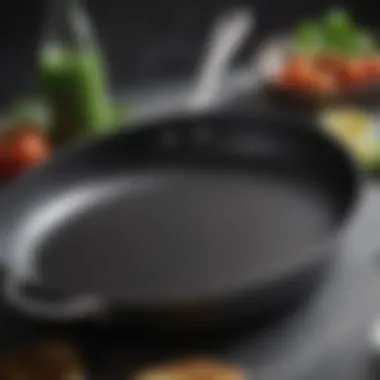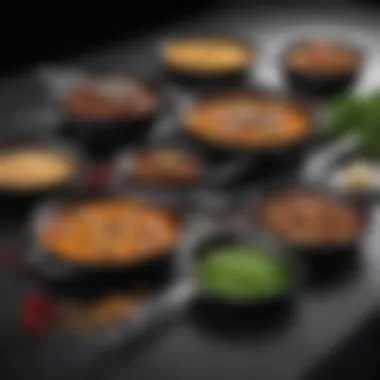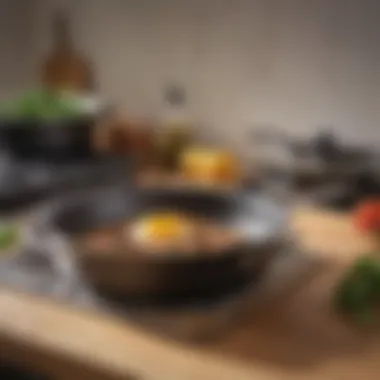The Essential Guide to Safe Non-Stick Cookware


Intro
When it comes to cooking up a storm, the right cookware can make all the difference. Among the myriad of options available today, non-stick pans have carved a niche for themselves, especially for those who seek convenient cooking without the hassle of scrubbing burnt food. But as we delve into this shiny world of non-stick tools, there’s a pressing question that lurks behind that smooth surface: Are they safe?
Non-stick cookware has evolved tremendously over the years. While they were once lumped together without much thought, today's best pans come with a variety of materials and coatings that can significantly impact both your health and how your food turns out. Not to mention, the easy cleaning aspect is a massive draw for busy folks who just want to whip up a meal without turning their kitchen into a disaster zone.
In this comprehensive guide, we aim to shine a light on these versatile cooking companions, exploring what makes a pan not just non-stick, but safe to use, too. We’ll take a stroll through the different types of non-stick coatings, highlight consumer tips, and provide insights into how to make an informed purchase that won't leave you second-guessing in the kitchen.
So, whether you're a seasoned chef or a novice burrito roller, this guide is tailored to help you navigate the nuanced world of non-stick cookware, ensuring you always have the right tools close at hand. Grab your apron, and let’s get cooking with confidence!
Preamble to Non-Stick Cookware
In the bustling world of culinary arts, non-stick cookware has become a staple in many households. It’s not just about convenience; these pans offer practical benefits that resonate with both everyday cooks and gourmet chefs alike. This section sets the stage by exploring the significance of non-stick cookware, its evolution, and the rationale behind its widespread use.
Historical Development of Non-Stick Surfaces
Non-stick coatings have a decidedly storied history, rooted in the mid-20th century. The rise of polytetrafluoroethylene, commonly known as Teflon, revolutionized home cooking. First discovered in 1938 by chemist Roy Plunkett, Teflon didn’t see widespread use until the 1960s, when it was adopted for cookware. Before the advent of these coated surfaces, cooking was often laden with the frustration of food sticking to pans and the challenge of cleaning stubborn residue.
As the decades rolled on, the non-stick pan evolved. Manufacturers began incorporating various materials and technologies, leading to a more diverse array of cookware options. Today, alternatives like ceramic and sol-gel coatings challenge Teflon’s dominance, highlighting evolving consumer preferences and environmental considerations. Understanding this evolution is crucial as it informs not only the choices available but also the underlying materials’ safety and efficacy.
Why Choose Non-Stick Pans?
The reasons to opt for non-stick pans stretch far beyond simplicity in cooking. First and foremost, non-stick surfaces significantly reduce the amount of oil or butter required. This translates to healthier meals with reduced fat content, appealing to health-conscious individuals.
Additionally, the ease of cleaning is an undeniable perk. Non-stick pans allow for quick wipe-downs, eliminating the need for extensive scrubbing. This feature is particularly valuable for busy people, where time is often of the essence. Stress melts away when one can go from cooking to enjoying a meal in record speed.
Another key point is versatility. Non-stick pans, when used correctly, can adapt to a variety of cooking techniques, from frying and sautéing to baking. They perform well across a range of temperatures, though caution is warranted with overheating.
"Choosing the right non-stick cookware isn't just about convenience; it's about making informed decisions that influence health and culinary quality."
However, potential buyers should remain mindful of the material and coating details. Not all non-stick pans are created equal, and knowing the differences can prevent health risks associated with certain chemicals found in older or lower-quality coatings. By understanding both their history and practical benefits, consumers are better equipped to make choices that enhance their cooking experiences while safeguarding their well-being.
Understanding Non-Stick Coatings
When it comes to selecting the right cookware, the kind of coating on a pan can make or break your cooking experience. Understanding the different types of non-stick coatings is essential for anyone who wants to elevate their culinary skills while keeping health and safety in mind. Each coating presents its own unique properties and trade-offs, influencing not just the cooking process but also the food's healthiness and flavor. By delving into this topic, consumers can make informed choices and find pans that stand the test of time—both in performance and safety.
Types of Non-Stick Coatings
Polytetrafluoroethylene (PTFE)
PTFE, often recognized by the brand name Teflon, is perhaps the most well-known non-stick material. One of its standout features is its exceptional non-stick qualities, allowing for minimal use of cooking oils and fats. This characteristic makes it a popular choice for those who are health-conscious and desire lower-fat cooking options. However, there's a downside as well; when overheated, PTFE can release fumes that may be harmful. It's crucial to keep PTFE pans below 500°F (260°C) to avoid these risks. The convenience it offers in terms of easy food release and cleanup adds to its appeal.
Ceramic Coatings
Ceramic non-stick coatings have gained traction as a perceived safer alternative to PTFE. These coatings are made from sand-derived silicon, making them completely free from toxic chemicals like PFAS. A major benefit of ceramic coatings is their ability to withstand higher heat compared to PTFE, which can reach temperatures around 700°F (371°C) without degrading. However, while ceramic pans may perform well initially, they often lack durability over time; the non-stick properties can diminish with consistent use and can become prone to chipping. For those seeking a chemical-free option, ceramic pans might still be a worthy consideration, but they may not have the longevity you might expect.


Sol-gel Non-Stick
Sol-gel technology is fairly new to the non-stick scene and uses a process that combines silica and polymers. The result is a coating that bonds to the pan's surface, providing a hard and scratch-resistant finish. Sol-gel non-stick pans can often handle higher temperatures and exhibit both durability and excellent food release capabilities. That said, the full adoption of sol-gel technology in the marketplace is still unfolding, and consumers should be aware that some pans may lean on the pricey side. It's an interesting option, though, combining the benefits of traditional non-stick and longevity without the nasty chemicals.
Benefits of Each Type
Ease of Cleaning
One of the most immediate benefits of all non-stick coatings is their ease of cleaning. Cookware with these surfaces prevents food from sticking, allowing for quick and effortless cleanup. Many home cooks can simply wipe a ceramic or PTFE surface with a soft sponge and some soapy water, eliminating stubborn, burned-on residues. This quality often leads to less time spent scrubbing and more time enjoying cooked meals, making non-stick options attractive for busy lifestyles.
Heat Retention and Distribution
Non-stick pans also provide good heat retention and distribution. High-quality pans distribute heat evenly across the cooking surface, preventing hot spots that can lead to uneven cooking. This characteristic becomes particularly crucial when preparing delicate foods like eggs or pancakes, where even cooking can determine the final result. Pans crafted with specific non-stick materials can help keep your culinary creations uniform and delicious.
Durability and Longevity
Finally, let's discuss durability and longevity. While each coating has its own lifespan, certain brands have engineered pans to withstand the test of time. PTFE pans made with reinforced coatings tend to have a long life if used properly, while ceramic and sol-gel options may require more careful handling to avoid wear and tear. Investing in higher-quality brands with a reputation for durable coatings can pay off in long-term satisfaction for consumers.
Safety Considerations When Choosing Non-Stick Cookware
When it comes to selecting non-stick cookware, safety should undoubtedly take precedence. Many people gravitate towards non-stick pans for the convenience they offer in cooking, but understanding the safety implications of these products is vital for ensuring a healthy cooking environment. Non-stick coatings have their merits, yet they come with potential hazards that one should not ignore. By delving into the specific health risks associated with these coatings and existing regulations, you can make informed decisions about your kitchenware.
Health Risks Associated with Non-Stick Coatings
Chemicals in Non-Stick Coatings
One of the primary concerns surrounding non-stick cookware relates to the chemicals used in their coatings. Many non-stick pans are made with polytetrafluoroethylene (PTFE), commonly known as Teflon. While PTFE itself is generally not harmful, the situation becomes troubling when pans are overheated. At high temperatures, typically above 500°F (260°C), PTFE can degrade, releasing fumes that may lead to flu-like symptoms known as "Teflon flu" in humans. Moreover, older non-stick coatings may contain perfluorinated compounds (PFCs), which have been linked to various health concerns, including certain cancers and liver damage.
It's crucial, therefore, to look for pans labeled as PFOA-free. This information can provide peace of mind, as it assures consumers that potentially harmful substances are absent. Additionally, opting for ceramic or other non-toxic coatings can serve as a safer alternative to traditional non-stick materials. The promise of easy cooking and cleaning should not compromise our health.
Effects of Overheating Non-Stick Pans
Moving beyond the chemicals themselves, the effects of overheating non-stick pans are also significant. Non-stick pans can warp or release toxic fumes if subjected to excessive heat. Even a quick glance in a hot pan can lead to some serious issues. When a pan overheats, it not only affects the coating's integrity but also impacts the foods prepared in such pans. For example, when residual Teflon breaks down, not all particles will stay confined to the surface. Some might enter the food, negating any health benefits one might hope to gain.
Additionally, responses to overheating vary among different materials. For instance, ceramic pans may have different temperature tolerances, but they can still crack under extreme conditions. Furthermore, it's vital to monitor cooking methods, as employing high heat for long periods can lead to uneven cooking results and potential food safety risks.
Regulations and Standards
In light of health concerns, various regulatory bodies have stepped in to establish guidelines ensuring consumer safety. Understanding these regulations provides a layer of assurance when purchasing cookware.
U.S. Food and Drug Administration (FDA) Guidelines
The FDA oversees the safety of materials used in non-stick coatings in the United States, having established guidelines that manufacturers must follow. These guidelines include ensuring that non-stick products do not leach harmful substances into food during normal cooking conditions. A key characteristic of these guidelines is that they are often informed by recent scientific studies, underpinning the evolving landscape of consumer safety. By adhering to these mandates, manufacturers can offer products deemed safe for daily cooking.
What's unique here is the proactive approach taken by the FDA. If issues or new findings arise regarding the safety of specific products, the FDA can adjust its recommendations accordingly. For consumers, this implies an added layer of trust, knowing there is a governing body consistently monitoring the safety of cookware.
European Union Regulations


Across the Atlantic, the European Union has implemented stringent regulations regarding non-stick cookware. EU regulations tend to be more comprehensive, encompassing specific bans on certain chemicals and demanding that manufacturers provide detailed safety assessments.
The key characteristic of EU standards lies in their transparency. Consumers can often find detailed information about what materials are used in their non-stick pans, along with their environmental impact. This thoroughness not only benefits health but also promotes sustainable practices in cookware production. Additionally, the EU's focus on sustainability presents manufacturers with the challenge of constantly innovating, ensuring safer and greener non-stick cookware options are available for consumers.
Top Picks for Safe Non-Stick Pans
When it comes to selecting non-stick pans, the options are as varied as the ingredients we cook with. The Top Picks for Safe Non-Stick Pans is a crucial section because it distills the mountain of choices into a more manageable and informed selection that is both safe and effective. While non-stick surfaces offer remarkable convenience, understanding which products stand out can mean the difference between a satisfying meal and a frustrating cooking experience. Furthermore, this selection not only focuses on safety but also considers factors like durability, ease of use, and price, making it paramount for cooking enthusiasts.
Best Overall Non-Stick Pan Options
In the realm of non-stick cookware, some models rise above the rest for their superior performance and user satisfaction. Tefal Professional Non-Stick Fry Pan is a stellar option. Crafted with a titanium-reinforced surface, it boasts impressive scratch resistance, which only adds to its lifespan. Plus, food glides off easily, making post-cooking cleanup a breeze.
Another worth mentioning is the GreenPan Valencia Pro. This pan is not just conventional; it's made with a ceramic non-stick coating that’s free from toxic chemicals, giving you peace of mind as you cook. It’s a non-stick dream come true for those who are health-conscious and yet don’t want to compromise on the performance.
Best Budget-Friendly Choices
Finding a reliable non-stick pan that doesn’t break the bank is not an unrealistic quest.
The AmazonBasics Non-Stick Fry Pan offers solid performance at a budget-friendly price. It features a multi-layer coating that provides decent non-stick results for everyday use, making it a go-to for basic cooking tasks without emptying your wallet.
Then there's the Calphalon Classic Non-Stick Fry Pan. With its hard-anodized aluminum body, this pan ensures even heat distribution, which is key for cooking dishes to perfection, all while being wallet-friendly. Plus, it offers a stay-cool handle, a nice touch for those long cooking sessions.
Best Non-Stick Pans for Professional Use
When seeking non-stick options suitable for a more relentless culinary environment, a host of features is paramount.
Scanpan Professional Fry Pan is a stand-out choice. Made in Denmark, this pan is designed for heavy-duty use, offering outstanding thermal efficiency along with an eco-friendly non-stick coating that withstands higher temperatures. Perfect for chefs who are not afraid to turn up the heat.
All-Clad HA1 Non-Stick Fry Pan is another top-tier choice for culinary professionals. Renowned for its stainless-steel core that delivers rapid and even heat distribution without hot spots, this pan merges high performance with the convenience of a non-stick surface. Chefs value its durability and the ability to work on various cooktops, including induction.
"Choosing the right non-stick pan isn’t just about coating; it’s about understanding how it fits into your cooking style and kitchen."
In summary, the selection of non-stick pans available today is extensive. By choosing one of the top picks highlighted above, culinary enthusiasts can enhance their cooking experiences without the worry of safety or performance. The journey through these non-stick options leads to not just better meals, but a more confident cooking practice.
Care and Maintenance of Non-Stick Cookware
Non-stick cookware offers convenience and ease in the kitchen, allowing food to slide out effortlessly. Yet, many users overlook the vital aspect of caring for these pans. Proper maintenance plays a crucial role in extending the lifespan of your non-stick cookware, ensuring that it remains safe and effective for years to come.
The significance of care and maintenance cannot be underestimated. Non-stick surfaces can degrade if not treated correctly, leading to compromised performance and safety. Understanding best practices for cleaning and proper storage takes your culinary experience to another level.
Best Practices for Cleaning
Keeping non-stick pans clean is a straightforward but essential task. Here are some seamless tips to follow:
- Cool Down First: Before diving into cleaning, allow the pan to cool entirely. Sudden temperature changes can warp the material.
- Gentle Wash: Use a soft sponge or cloth, coupled with mild dish soap, to wash the pan. Avoid scrubbing pads or harsh chemicals that could damage the coating.
- Rinse Thoroughly: Ensure all soap residues are rinsed off, as they can affect the flavor of your food during the next use.
- Dry Properly: After rinsing, dry your non-stick pan completely to prevent moisture buildup, which can lead to rust or other damage.
"A well-cared-for pan is a happy pan!"
By following these straightforward steps, you maintain not just the look of your cookware, but its performance too. Over time, improper cleaning can lead to a build-up of residues, affecting how certain foods cook.


Storage Tips to Prevent Damage
Proper storage is as important as cleaning when it comes to maintaining your non-stick cookware. It's easy to overlook storage strategies, but neglecting this step can lead to scratches, dents, or warping. Here’s how to store them effectively:
- Use Pan Protectors: Invest in soft, thin mats to place between your pans. This acts as a cushion, preventing scratches.
- Stack with Caution: If you have to stack your non-stick pans, be cautious. Avoid placing heavy items on top, which may lead to dents or pressure on the coating.
- Hang When Possible: If your kitchen allows, consider hanging your pans. This prevents unnecessary contact with other cookware, preserving their surface.
- Keep Away from Heat Sources: Store your cookware in a place where it won’t be exposed to direct heat or sunlight, as prolonged exposure can warp the material.
Adhering to these care and storage guidelines provides not only optimal cooking results but also safety, as damaged pans can lead to unhealthy cooking conditions. Emphasizing these practices leads to rewarding experiences in your culinary adventures.
Cooking Techniques with Non-Stick Pans
When it comes to utilizing non-stick cookware, the right cooking techniques play a fundamental role in maximizing performance and culinary outcomes. With their smooth surfaces, non-stick pans often become the stars of the kitchen, offering specific advantages if used correctly. Understanding these techniques not only enhances food preparation but also prolongs the lifespan of the pans. After all, a bit of finesse can make even the simplest meals shine.
Optimal Heat Settings
Getting heat settings right is pivotal when working with non-stick pans. High temperatures can lead to overheating, which often detracts from the integrity of the non-stick coating. Therefore, most experts recommend cooking at medium to medium-high heat. This way, you can ensure even heat distribution without compromising the material.
Using a lower heat setting might be preferable for delicate foods like eggs or fish, enabling a gentle cooking process that prevents sticking. On the other hand, for searing meat or sautéing vegetables, medium-high works just fine. Remember, a subtle hissing when food hits the pan is a good indicator that the temperature is just right. Here are some tips:
- Preheat the Pan: Always give the pan a minute or two to preheat before adding fat or food. This helps create an even cooking surface.
- Avoid Excessive Oil: Too much oil can cause build-up and eventually impact the non-stick quality. A light coating is usually sufficient for most meals.
- Use the Right Utensils: Silicone or wooden utensils are recommended as metal ones might scratch the surface and compromise functionality.
In summary, being mindful of the heat not only helps in achieving desirable cooking results but also safeguards the non-stick coating from damage.
Food Pairings that Work Best
Non-stick pans shine particularly with certain types of food, harmonizing beautifully to create culinary magic. Here’s a closer look at the food pairings that show remarkable compatibility:
- Eggs: Whether scrambling, frying, or making omelets, eggs glide easily on non-stick surfaces, typically resulting in perfect, non-crispy edges.
- Pancakes: The ability to flip pancakes smoothly is perhaps one of the best uses of non-stick pans. Without the fear of disastrous flips, creating a brunch spread becomes effortless.
- Delicate Fish: Cooking fish like salmon or tilapia in non-stick pans can render delightful outcomes, as the fish won’t stick and will hold its shape beautifully.
- Stir-Fried Vegetables: Quick stir-fries benefit from the non-stick surface, allowing veggies to crisp up without losing their vibrant colors.
"Non-stick pans can be a game changer if seasoned well with care and used correctly".
Lastly, understanding these food pairings not only enhances taste but also elevates the overall cooking experience. By choosing the right foods for non-stick pans, you ensure a hassle-free cooking session and delicious results every time.
Environmental Impacts of Non-Stick Pans
When diving into the realm of non-stick cookware, it’s essential to consider how these everyday items impact our environment. Many don’t realize that the materials and production processes behind non-stick pans can have significant effects on our planet. This section sheds light on those issues while also emphasizing the importance of making informed choices.
Sustainability of Non-Stick Materials
The sustainability of non-stick materials is an increasingly pressing concern in our plastic-filled world. Common coatings like Polytetrafluoroethylene, often called Teflon, come under scrutiny due to the byproducts formed during their production. One of the more notorious culprits was perfluorooctanoic acid (PFOA), which raised eyebrows for its potential environmental and health risks. Though major manufacturers have phased out PFOA, other chemicals still used could contribute to ecological problems.
On the flip side, some brands are leading the charge towards more sustainable options. For example, ceramic-based non-stick coatings tout environmentally friendly production processes while reducing reliance on harmful chemicals. Such products appeal to eco-conscious cooks who care about both their health and the planet.
When pondering sustainability, it's worth considering durability, too. A longer-lasting pan means reduced waste and less frequent replacements. Thus, investing in high-quality, eco-friendly cookware not only fulfills culinary needs but also minimizes detrimental impacts on our environment.
Recycling Non-Stick Cookware
Recycling non-stick cookware requires some understanding of the underlying materials. While metals like aluminum and stainless steel can often find new life after being melted down and reshaped, non-stick coatings complicate matters. The layers of polymer that make pans non-stick often don’t mesh well with traditional recycling processes. As a result, many pans end up in landfills, adding to the growing waste problem.
However, there are initiatives in place aimed at tackling this issue. Some companies encourage customers to return their old pans for recycling, often providing discounts on new purchases as an incentive. Moreover, organizations are emerging that specialize in metal recycling, which can sometimes process non-stick cookware if stripped of its coatings.
"A stitch in time saves nine." This old saying holds true here—taking care of your non-stick pans can extend their life, potentially keeping them out of landfills for a longer stretch.
To enhance recycling efforts, consumers need to be proactive. Understanding the material composition of their cookware can help in making the right recycling choices. Furthermore, opting for companies that prioritize sustainability and offer recycling programs is key. At the end of the day, choosing wisely means not just considering immediate culinary needs but also the long-term implications for our world.







